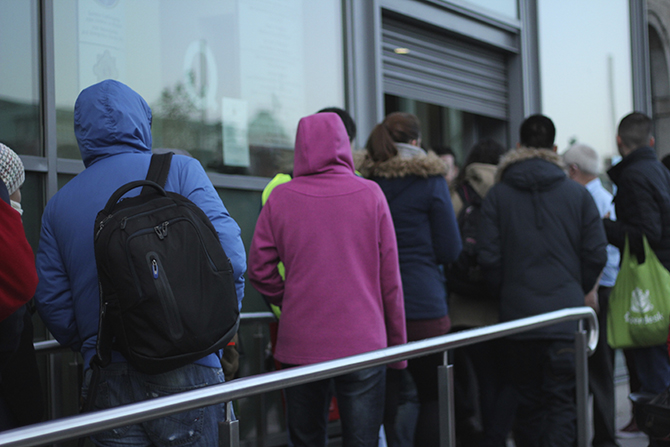
Queues begin to form as early as 4am on busy days. Much like Willy Wonka’s chocolate factory, only a set number (400) of tickets are handed out on any given day. Visitors will not be attended to without the coveted scrap of paper. So their hopes of getting their paperwork sorted rely on arriving as early as possible.
João Paulo, an English student at Durst College, looks at the process with a sense of humour. Suffering from a cold and bundled up against the weather he said, “It’s a nice day to stand in lines.” Having arrived at 8:00am at the GNIB building, João exuded the optimism of one enduring the procedure for the first time. Much like Rachel who arrived just an hour earlier.
Rachel, an exchange student at Dublin City University, arrived at 6:50am to register at immigration for the first time since arriving in Ireland. The business major found the queue enveloping the block, ending close to the start. She laughed saying, “This is the first and last time I plan to do this.” Located near the entrance, she may be right. However, many students have not been so lucky.
Take Sofia, a postgraduate medical device design student at the National College of Art and Design. She arrived at 7:30am for her second attempt to register at the GNIB. She recalled waiting for three hours on her first try before they had run out of tickets. Sofia asks for more support for students, suggesting separate lines to prevent such messy queues. “If only there were an option to register online,” she commented, “it would make it quicker.” In comparison, any meeting at immigration in the United States must be set by appointment beforehand. In the interests of security and efficiency, these appointments with an official are allocated after an online registration.
Sofia is particularly desperate to register immediately as she came over from Mexico on a scholarship and can only access the funds once registration has been completed. “Applying for a visa was already a problem,” she lamented. “I kept calling the embassy and getting confusing answers, and now I won’t get paid until this is sorted.”
Registration at the GNIB office requires a particular set of documentation, including: proof of finances in an Irish bank account, proof of medical insurance, and a letter from the student’s college. While these are not unrealistic demands, for some they can be inconvenient.
“As a postgraduate student, I plan to be here for less than a year in total,” said a TCD student who wishes to remain unnamed, “but they want me to demonstrate my finances in an Irish bank account, which I didn’t plan on opening since I won’t be here that long.”
The financial aspect to registration also elicits groans from students. Completion of the process requires a fee of €300; but that is just for registration. Another €100 must be paid in order to acquire a re-entry visa, since single entry visas are assigned after the initial application to enter the country.
The TCD student continued, “The documents ask that I get the university to justify any time I spend out of Ireland, how long I’ll be gone and when I will resume my studies, which is a bit invasive if you ask me. I was just thinking of catching up with some friends in England for the weekend.”
The day I registered, I only waited two hours outside, but another five inside.
Having arrived six months ago, Matheus has already endured the process, but found himself in line again, this time, to keep his friend company. The English student at the National College of Business Administration admitted to having returned several times in order to register. Matheus shook his head at the queue, “It did not used to be this bad before,” he noted. “The day I finally managed to get in I got here at 10am.” He said, “The day I registered, I only waited two hours outside, but another five inside.” If making it into the building is a sprint, then waiting inside is a test of endurance.
The end of September brings a large batch of new students to the area, as well as a considerable drop in temperature. “It is too cold to spend this long outside,” comments Matheus, “it is kind of a lack of respect to make us stay like this.” His companion joked, “Europe is too bureaucratic. We might as well be back in Brazil.”
On the other hand, it is understandable that the government has these measures in place to monitor the increasing number of international students. According to data from the Irish Council for International Students, Dublin universities DCU, TCD and UCD saw 43,117 full-time international students in the 2012/2013 academic year. This does not include figures from the regional colleges and part-time students.
Such large volumes of people allow for some to slip through the cracks and take advantage of the arrangement. However, the ratio of genuine students to system abusers is so disproportional, it seems unfair that they ruin the system for the remainder.
The number of enrolled international students is expected to increase in the results of the data from the 2013/2014 academic year. With this in mind, the GNIB should really consider updating their system as not only would they, and the students, benefit from a faster, more efficient registration procedure, but the business owners around the block would no longer have to worry about the masses of people blocking traffic into their stores.
Photos: Huda Awan









